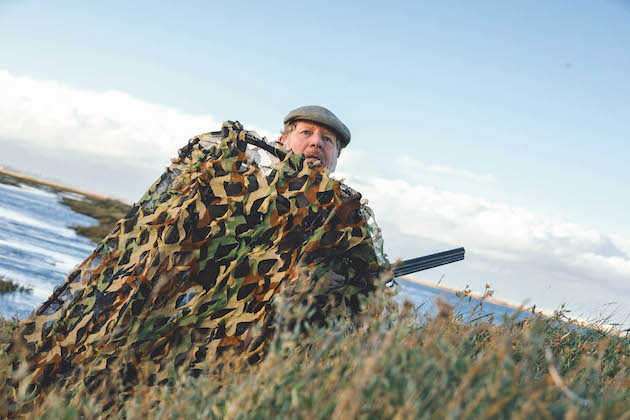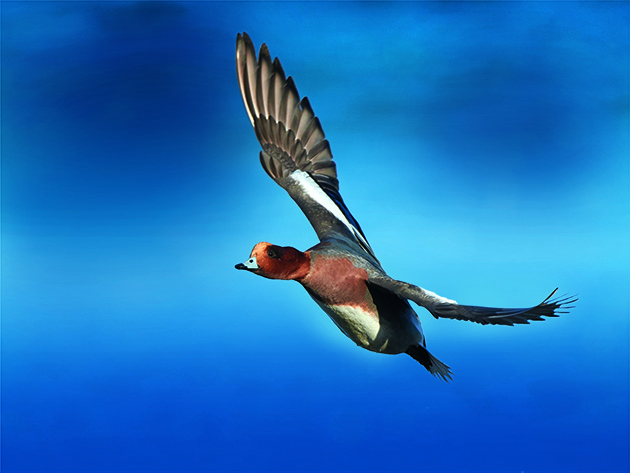Win CENS ProFlex DX5 earplugs worth £1,149 – enter here
How to be a successful and stealthy wildfowler
 Mike Swan wildfowling on the river medway.
Mike Swan wildfowling on the river medway.
If your only experience of shooting wildfowl is driven mallard, you could be forgiven for failing to realise that you need to be well hidden if you really want to stand much chance at wild ducks and geese in broad daylight. (Here’s how to identify different duck species.) On the other hand, there is a lot of nonsense talked about the ‘essential’ nature of camouflage clothing, as well as the use of a lot of other specialist equipment. So what are the real rules that you need to abide by in order to be a successful wildfowler? (By the way, here’s our list of the best wildfowling gear.)
Keep still
Wildfowler stillness
It’s remarkable what you can get away with if you keep still. Ducks and geese are very quick to spot movement, but will often do silly things if you play dead. So do not shuffle about in your hide as they approach and, if you are decoying, be prepared to wait for birds to circle over you and drop lower. Usually, if you are impatient and try to steal a glance at what they are doing, the game is up. If you need to move at the last minute to shoot, fair enough, but with experience you can often figure out from what the approaching birds are doing when the moment is right, position accordingly while they are still well out then keep still.
Shades of grey
Modern camouflage patterns are a great help, but they are not the be all and end all. A plain jacket or jumper can work fine for a wildfowler, but it does help if it matches the tone of the world you inhabit. Being tonally in tune matters more than colour, so a dark wax jacket among the pale, dead grass of a marsh in winter can stick out like a sore thumb. I’d rather a tonally correct jacket in plain grey than an ex-army disruptive pattern material camouflage that is meant to hide a soldier in a dark pine forest but is much darker than my surroundings. Colour is much less important and bothers me very little. I would choose green and brown over red and blue, but not by that much. As an aside, one of the reasons I choose golden retrievers as my wildfowling companions is that they match the colour and tone of the marsh much better than the likes of a black labrador and are therefore easier to hide.
Low profile
A wildfowler should keep low and try to have a good background. The final approach to decoys is pretty much always into the wind, so hiding on the downwind side of something allows you to keep your head right down, even for birds skimming over the marsh surface. They will surely still spot you as you start to mount the gun, but if you have judged it right, that is too late from their point of view.
Hit the deck
If you get caught out in the open, you may stand a chance at approaching fowl if you act quickly, before they spot you. Running for cover draws attention and kneeling or squatting down is rarely good enough, but lying prone can work. The trick is to lie still on your back, with your feet towards the bird or birds and your gun lying across your chest, ready to mount. If you sit up quickly when the birds are in range, you may succeed in getting a shot. This has worked for me and, on one memorable occasion, I pulled off a right-and-left at pinks. (Take a look at our pick of ammunition for wildfowlers.)
When building a hide, using a thin screen allows a view of the approaching birds without the need to look over the top
Peer through
If you follow my advice and think about background, you can afford to hide behind a remarkably thin screen. This, in turn, allows you to see through your cover and watch approaching birds without the need to look over the top.
To build my wildfowler hide, I much prefer a net with pieces of scrim attached, rather than a sheet of solid scrim alone. If needs be, I would also double up the netting behind me to give a really solid background, rather than having extra cover in front. Having the hide higher behind you is good practice and, at times, I even leave a narrow opening at the front. This allows me to shoot low over the decoys without bobbing up and gives my dog a good view of most falling birds. However, if all your wildfowl shooting is flighting in deep dusk, you can afford to ignore most of this and, provided you keep still, you can probably get away with simply kneeling with no extra cover at all. Even so, I would always cultivate a low-profile and skulking approach, in both daylight and dusk. If nothing else, it helps you cultivate the right attitude in trying for a properly wild quarry and that will help to put birds in the bag.
A mask or scarf, or even a beard, can be used to obscure a pale face from quarry
Hide your face
Pale faces stick out like a sore thumb, so while people with darker skin may be able to get away with it, anyone with my type of complexion who looks directly at a bird must expect it to shy away. If you are happy with a mask, or a camo scarf drawn up over your face, by all means use one, but I hate these things. Once upon a time, I had a ginger beard and one of my excuses for not shaving was that it was useful for hiding my pale face when wildfowling. Now the said beard has gone pale grey, it is probably counterproductive, but it still lags the pipes and helps to keep me warm in winter.
Many fowlers have suggested that a broad-brimmed hat can help to shade your face and therefore improve concealment. While the brim can certainly help to keep the sun out of your eyes, I beg to differ. The trouble is, the broader the hat’s brim, the more of your face you need to turn up towards the birds. My father always wore what he referred to as a woolly titfer — a simple hand-knitted hat pulled down over his forehead. That way, he could peer at the birds from under his eyebrows, while keeping his face turned down. Now my mother is no longer knitting these hats, I use a simple tweed cap, with only a short peak.
Most fowling happens with a dog, and I hate to be without mine, but you do need to think about hiding the dog as well as yourself. You need a hound that will sit quietly and not fidget. On the other hand, it is good to have it where it can mark a falling bird, rather than hidden at your feet. Many years ago, I remember a pack of wigeon that seemed committed but suddenly flared at the last minute for no obvious reason. Must have seen something, I thought, then a second lot did the same. On the third time, I rumbled the cause — my lovely Cloth Ears was about six and her face had gone very grey. Those wigeon had spotted her looking up at them. After that, she had a mud facial every trip out on to the marsh.
Related Articles
Get the latest news delivered direct to your door
Subscribe to Shooting Times & Country
Discover the ultimate companion for field sports enthusiasts with Shooting Times & Country Magazine, the UK’s leading weekly publication that has been at the forefront of shooting culture since 1882. Subscribers gain access to expert tips, comprehensive gear reviews, seasonal advice and a vibrant community of like-minded shooters.
Save on shop price when you subscribe with weekly issues featuring in-depth articles on gundog training, exclusive member offers and access to the digital back issue library. A Shooting Times & Country subscription is more than a magazine, don’t just read about the countryside; immerse yourself in its most authoritative and engaging publication.








